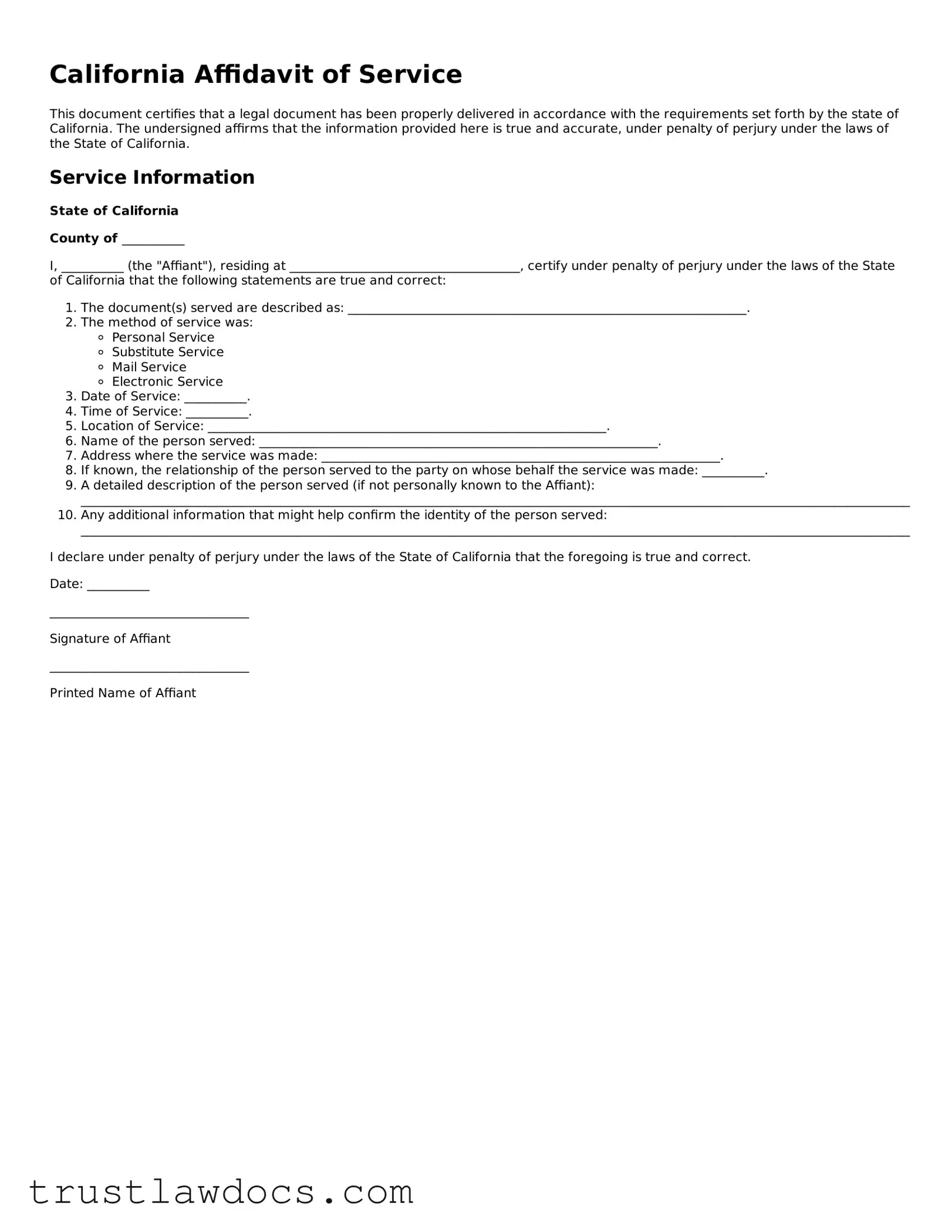What is an Affidavit of Service in California?
An Affidavit of Service is a legal document used in California to verify that a legal document, such as a summons, complaint, or any other court-related document, has been properly delivered to a party involved in a legal proceeding. It is usually filled out by the individual who served the documents, providing details about when, how, and where the documents were served, thereby ensuring the adherence to due process.
Who can serve legal documents in California?
In California, legal documents can be served by anyone who is not a party to the case and is at least 18 years old. This includes professional process servers, county sheriffs, and in some cases, friends or relatives. It's important that the person serving the documents understands the legal requirements for service to ensure it is done correctly.
What types of service are acceptable under California law?
California law recognizes several methods of service, including personal service, where the documents are handed directly to the person; substitute service, where they are left with someone at the person’s home or business and then mailed to the person’s last known address; service by mail, where the documents are mailed to the person’s last known address; and, in some instances, service by publication, where the notice is published in a newspaper when the person cannot be located. Each method has specific requirements to be legally effective.
How do I fill out an Affidavit of Service?
To fill out an Affidavit of Service in California, you’ll need to include the case information, such as the case number and court. Describe the documents served, the person they were served to, the date, time, and method of service, and any additional details required, such as the address where service was made. The server must then sign the affidavit, often in the presence of a notary public, who also signs and seals the document.
Is notarization required for an Affidavit of Service in California?
While not always mandatory, notarization of an Affidavit of Service is highly recommended in California. Notarization provides an additional layer of verification, attesting to the identity of the server and the truthfulness of the affidavit. Some courts or legal proceedings may specifically require a notarized affidavit, so it’s best to confirm the requirements for your particular situation.
What happens if service is not properly made under California law?
If service is not properly made according to California law, it can have significant consequences. The court may dismiss the case or not allow it to move forward until proper service is accomplished. Improper service also means that the court may not have jurisdiction over the person served, making any orders or judgments issued potentially invalid. It's crucial to ensure service is done correctly to avoid these complications.
Can I serve documents by email or social media in California?
Serving documents by email or social media is not typically allowed as the primary method of service in California. However, under certain circumstances and with court approval, electronic service might be permitted, especially if other methods of service have been unsuccessful or are impractical. It is essential to consult the specific rules of the court handling the case to understand what methods of service are acceptable.
What should I do after completing the Affidavit of Service?
After completing the Affidavit of Service, you should file it with the court clerk in the court where the legal proceeding is taking place. This serves as official proof that the other party was served in accordance with the law, allowing the court case to proceed. Make sure to keep a copy for your records.
Is there a deadline for filing an Affidavit of Service in California?
Yes, there are deadlines for filing an Affidavit of Service, which can vary depending on the type of court case and the method of service used. Generally, the affidavit should be filed as soon as possible after the service is completed to avoid delaying the legal process. Check the rules of the specific court and type of case to ensure compliance with all deadlines.
Where can I find an Affidavit of Service form for California?
California's Affidavit of Service form can be found on the website of the California Courts or obtained directly from the clerk's office of the court where your case is filed. Some counties may have their own specific forms, so it's essential to use the form that corresponds to the court handling your case to ensure that it meets all local requirements.
